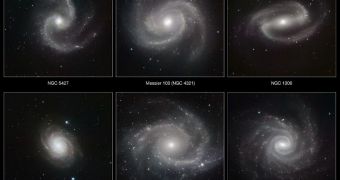Astronomers at the European Southern Observatory (ESO) obtained six new beautiful images of galaxies recently, when they trained the HAWK-I camera on their Very Large Telescope (VLT) at the cosmic structures.
The result was a series of photographs that depicted the very essence of the six galaxies, say experts with the VLT, at the Paranal Observatory in Chile.
The HAWK-I camera is an impressive infrared detector, which is capable of peering through the Universe with ease. At this point, ESO experts use it to understand how spiral galaxies appeared and developed in the early Universe.
This instrument was only recently installed on the VLT, which is currently considered to be one of the most advanced astronomical telescope in existence. It features 4 primary telescopes, and eight secondary ones, all of which function together via interferometry.
With this technique, the 8 observations post can act as a massive, single-aperture telescope, featuring a diameter as long as the maximum length between the individual telescopes making it up.
Due to the sensitivity HAWK-I has, it can penetrate vast clouds of cosmic dust, and peer at the stars underneath. Galaxies' spiral arms therefore become easy to notice, unlike when using other telescopes.
“Compared to the earlier, and still much-used, VLT infrared camera ISAAC, HAWK-I has sixteen times as many pixels to cover a much larger area of sky in one shot and, by using newer technology than ISAAC, it has a greater sensitivity to faint infrared radiation,” ESO says in a press release.
“Because HAWK-I can study galaxies stripped bare of the confusing effects of dust and glowing gas it is ideal for studying the vast numbers of stars that make up spiral arms,” the organization adds.
The ESO group, led by investigator Preben Grosbol, wants to determine how galaxies evolve to take on their perfectly-defined spiral shapes. This could have significant implications for understanding the early evolution of the Universe.
Astronomers have just begun exploring the six images, which are incredibly detailed, with a level of sharpness that is only possible with data collected in infrared wavelenghts.
HAWK-I will be used for other studies as well, as researchers shift their focus from newer to older galaxies, or from spiral to barred spiral and barrel ones.

 14 DAY TRIAL //
14 DAY TRIAL //